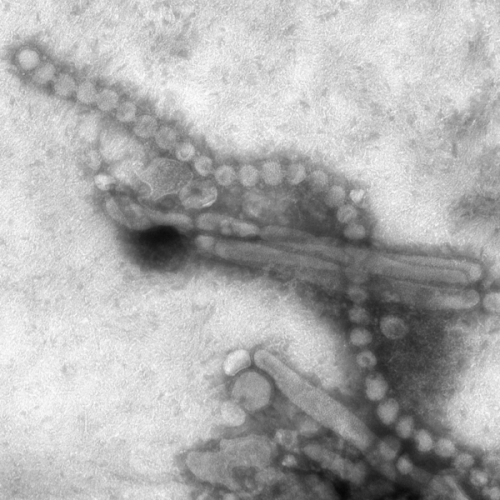January 7, 2014 report
Study finds some people less susceptible to H7N9 influenza virus than others

(Medical Xpress)—An international team of researchers working at the University of Melbourne in Australia has found that genetic differences in people result in different degrees of ability to fight the H7N9 influenza virus. In their paper published in Proceedings of the National Academy of Sciences, the team reports that their study of immune response observed in blood samples indicates that some people may be far better equipped to fight off the new flu strain than others.
After observing differing degrees of immune response in blood samples obtained from 52 human donors, the researchers looked a little closer to discover why it occurred and whether something could be done about it. In so doing, they discovered that a difference in a protein complex that is part of the immune response was responsible for the different immune response levels.
The H7N9 influenza virus first appeared in China, in February of last year (likely after jumping from domestic fowl—137 were infected, 45 died) and as such, has never before been seen in humans. Because of that, people have no antibodies ready to go to war upon recognition of the virus. Some people, however, have a type of lymphocyte (CD8+ T) that serves in its stead—they generally come to exist after battling some other type of flu strain. Often, the result is some degree of immune response, which aids in fighting off the virus. Those that don't have the lymphocyte are left to fight the virus as an unknown foreign entity, which means a broad response –one that is far less effective in overcoming the virus.
The team notes that there appears to be a regional factor involved—those people native to Alaska and Australia, for example, tend to not have the lymphocyte and are thus much more susceptible to the symptoms of the new flu strain.
More specifically, the researchers found that 16 to 57 percent of people in the study (which they believe corresponds roughly to the general population) had some degree of immune response due to CD8+ T—some of which appeared to respond to any flu virus that was introduced. That of course leaves a large portion of the public at risk.
To counter the new virus, researchers are working on a universal T-cell vaccine that would supplement the normal flu vaccine that people already have access to—the hope is that it can be developed before late winter in the northern hemisphere—the time when the virus would become most prevalent.
More information: Preexisting CD8+ T-cell immunity to the H7N9 influenza A virus varies across ethnicities, PNAS, www.pnas.org/content/early/2014/01/03/1322229111
Abstract
The absence of preexisting neutralizing antibodies specific for the novel A (H7N9) influenza virus indicates a lack of prior human exposure. As influenza A virus–specific CD8+ T lymphocytes (CTLs) can be broadly cross-reactive, we tested whether immunogenic peptides derived from H7N9 might be recognized by memory CTLs established following infection with other influenza strains. Probing across multiple ethnicities, we identified 32 conserved epitopes derived from the nucleoprotein (NP) and matrix-1 (M1) proteins. These NP and M1 peptides are presented by HLAs prevalent in 16–57% of individuals. Remarkably, some HLA alleles (A*0201, A*0301, B*5701, B*1801, and B*0801) elicit robust CTL responses against any human influenza A virus, including H7N9, whereas ethnicities where HLA-A*0101, A*6801, B*1501, and A*2402 are prominent, show limited CTL response profiles. By this criterion, some groups, especially the Alaskan and Australian Indigenous peoples, would be particularly vulnerable to H7N9 infection. This dissection of CTL-mediated immunity to H7N9 thus suggests strategies for both vaccine delivery and development.
© 2014 Medical Xpress














